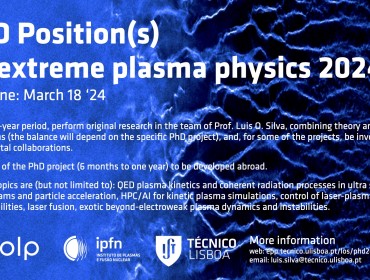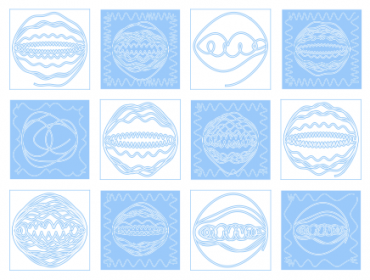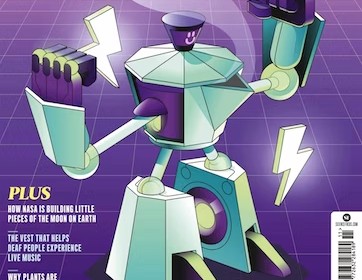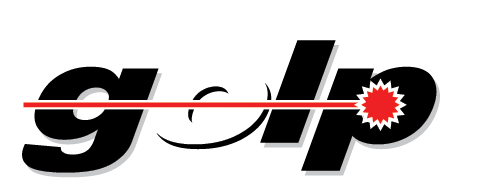-
Epp project selected as EuroHPC Success Story
Read moreThe computing project led by epp team member J. Vieira was selected as a Success Story of the EuroHPC Joint Undertaking. The project, titled ‘Plasma Accelerator-Based Light sources’, focused on the possible use of collective plasma motion to emit very bright radiation. Project highlights include using structured light to enhance ion acceleration (lead by epp team member C. Willim, published here in Physical Review Research); a new mechanism to mitigate the hosing instability in plasma accelerators (lead by former epp team member M. Moreira, published in Physical Review Letters); and a superradiant quasiparticle light sources in plasma accelerators , which leveraged the Radiation Diagnostic for Osiris (https://doi.org/10.1016/j.cpc.2022.108634, also check the video).
A plasma wave (in blue) excited by a laser can travel at speeds faster than the speed of light, generating bright single-cycle light…
May 17, 2024 -
GoLP Research Featured in Physics of Plasmas
Read moreA recent paper by GoLP researchers has been chosen as Editor’s Pick in the American Institute of Physics’ (AIP) journal Physics of Plasmas. This distinction recognizes the research’s potential impact, clarity, and overall quality. The study explores the behavior of plasmas under extremely powerful electromagnetic fields, encountered in both labs with ultra-intense lasers and around celestial objects like pulsars and magnetars. The team’s findings reveal that radiation emitted from hot plasmas in such fields can alter their equilibrium state. These results may hold the key to explaining puzzling astrophysical observations, suggesting a different behaviour for plasmas surrounding these objects than previously thought.
May 16, 2024 -
PhD position(s) in extreme plasma physics 2024
Read moreDuring a 4-year period, perform original research in the team of Prof. Luis O. Silva, combining theory and simulations (the balance will depend on the specific PhD project), and, for some of the projects, be involved in experimental collaborations. Some part of the PhD project (6 months to one year) to be developed abroad.
Possible topics are (but not limited to): QED plasma kinetics and coherent radiation processes in ultra strong fields, fireball beams and particle acceleration, HPC/AI for kinetic plasma simulations, control of laser-plasma topology and instabilities, laser fusion, exotic beyond-electroweak plasma dynamics and instabilities.More information click here.
February 7, 2024 -
Mini-workshop on laser-plasma interactions and applications
Read moreOn Thursday 8th of February, GoLP will host a mini-workshop (in Abreu Faro, at IST) on laser-plasma interactions and applications.
The mini-workshop program is the following:
GoLP Mini-workshop on ultra-intense laser-plasma interactions: from plasma-accelerators to compact light sources (and more…)
Ultra-intense laser-plasma interactions emerge when ultra-intense laser pulses (I>10^18 W/cm^2) interact with plasma. At these intensities, the collective plasma response results in structures suitable for applications ranging from compact accelerators to light sources. This mini-workshop will review key developments in this field combining experimental, theoretical and computational advances.
15:00 – Development and applications of laser-plasma acceleration,
Olle Lundh, Lund University (Sweden)
15:30 – Direct laser acceleration with the next generation of lasers,
Marija Vranic, Instituto Superior Técnico (Portugal)
16:00 – PIC simulation for the understanding of fundamental plasma process and particle/photon sources,
Xavier Davoine, CEA (France)
16:30 – Coffee break
Don’t miss it!Image Credits: Róbert B. The picture shows the trajectories in the phase space of electrons accelerated by the direct…
January 31, 2024 -
Mini-workshop on Plasma Accelerators
Read moreFriday 23rd of January, GoLP hosted a mini-workshop on Plasma Accelerators. Here follows the program and some photos from the event.
Mini workshop on plasma accelerators
The increasing size and cost of conventional accelerators motivates the development of more compact accelerators. Because plasmas can sustain very high electric fields, plasma-based accelerators are a promising concept to miniaturize the size and cost of accelerators. Thanks to recent advances, plasma-based accelerators have been included in the 2020 update of the European Strategy for Particle Physics as a high priority research initiative. This mini-workshop will provide an overview of plasma-based accelerators for lepton and ion bunches, including recent advances in theory, simulation and experiments, and its connections to laboratory astrophysics.
Location: Anfiteatro Abreu Faro
Program:
14:00 – Coffee and cookies
14:30 – Plasma for particle acceleration, Alexander Pukhov, University of Dusseldorf, Germany
15:00 – New developments on laboratory astrophysics, Robert Bingham, University of Strathclyde and Rutherford Appleton Laboratory, UK
15:30 –…
January 31, 2024 -
GoLP and FRONTIERS: Bridging Science and Journalism
Read moreFRONTIERS is a science journalism initiative funded by the European Research Council, running from 2023 to 2027. Its main goal is to facilitate collaboration between scientists and journalists which envisions a world where they can unite to communicate accurate scientific information, building public trust in science, combating misinformation, and fostering social resilience.
The Group of Lasers and Plasmas (GoLP) at Técnico is one of the institutions hosting journalists from FRONTIERs and it was highlighted in the first announcement, here. GoLP is known for its unique approach to blending theory, experiments, and simulations.. Through GoLP, journalists can access experimental, theory and simulation efforts, unique media resources, and global collaborations with institutions like UCLA, Oxford, and CERN. FRONTIERS offers a unique opportunity to contribute to a collaborative, informed society. More information on how to apply can be found here.
January 22, 2024 -
Epp members’s Quasiparticle Light Source Concept Highlighted in BBC Science Focus
Read moreThe recent paper lead by epp team members Bernardo M, Miguel P, Ricardo F, and Jorge V, recently published online in Nature Photonics (link here), on a novel quasiparticle light source concept, was also featured as a main news story in the November issue of the journal BBC science focus. BBC science focus is a British printed science and technology journal. Besides the printed version, the news piece is also available online here.
November 22, 2023 -
Frederico Fiúza formally inducted as APS fellow at APS 2023, Denver (Colorado)
Read moreDuring the 65th Annual Meeting of the APS Division of Plasma Physics, held on 30th of October to the 3rd of November, 2023 in Denver, CO, Frederico F was formally inducted as a Fellow of the American Physical Society in recognition of his contributions in plasma physics. His citation reads: “For leadership and fundamental contributions to the plasma physics of energetic particle generation from collisionless shocks, magnetic reconnection, and MHD instabilities.
November 5, 2023 -
Epp team members attend 65th Annual Meeting of the APS Division of Plasma Physics
Read moreSome of our epp team members went to Denver, CO to attend the 65th Annual Meeting of the APS Division of Plasma Physics, held on 30th of October to the 3rd of November, 2023, and presented a talk about their recent work.
In the picture: Rui T, Pablo B, Marija V, Camilla W, Miguel P, Diogo C and Óscar A. Pablo B had an invited talk, and the rest of the members had a contributed talk on their work.
Here, some pictures from the event:
November 5, 2023 -
Frederico Fiúza elected Fellow of the American Physical Society
Read moreGoLP member Frederico Fiúza has been elected Fellow of the American Physical Society in recognition of his contributions in plasma physics. His citation reads: “For leadership and fundamental contributions to the plasma physics of energetic particle generation from collisionless shocks, magnetic reconnection, and MHD instabilities.”
The APS Fellowship Program was created to recognize members who may have made advances in physics through original research and publication or made significant innovative contributions in the application of physics to science and technology. Election to this Fellowship is limited to no more than one-half of one percent of the membership and is a recognition by peers for outstanding contributions to physics. To find out more about him you can click here.
October 20, 2023
extreme plasma physics > News


















